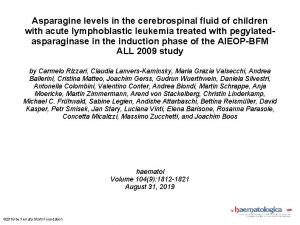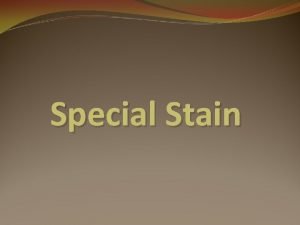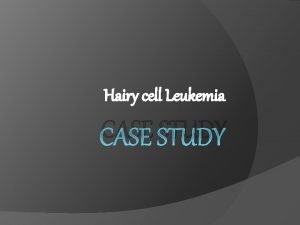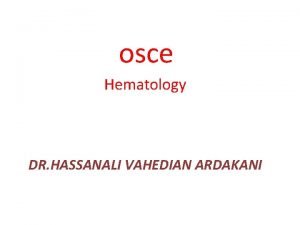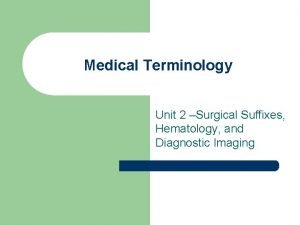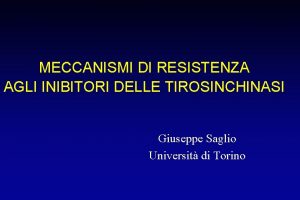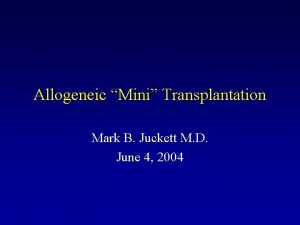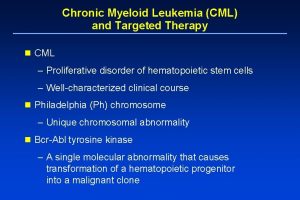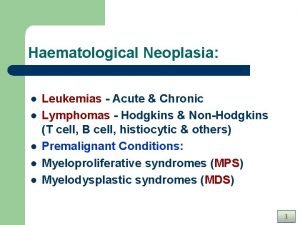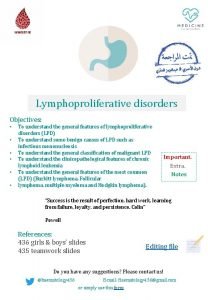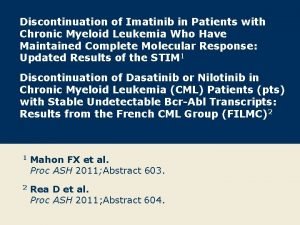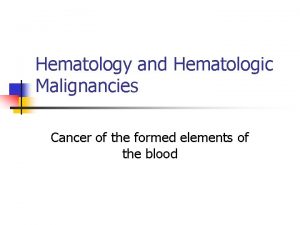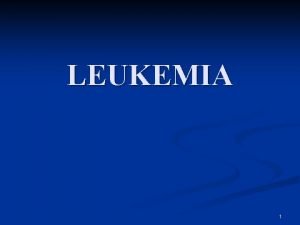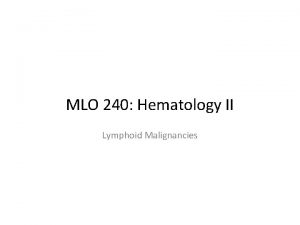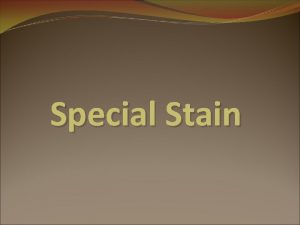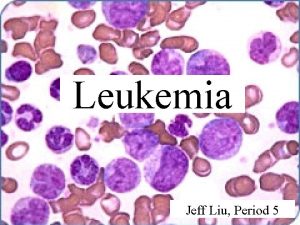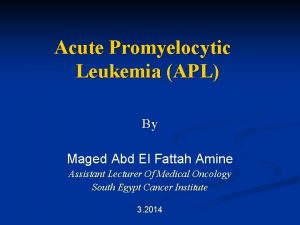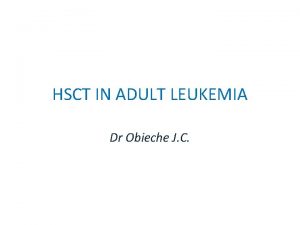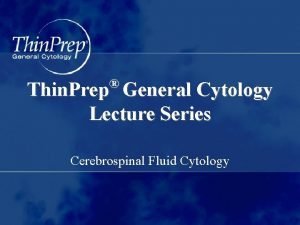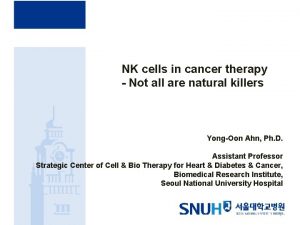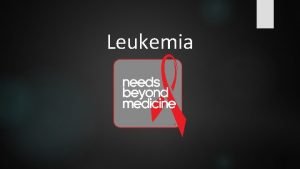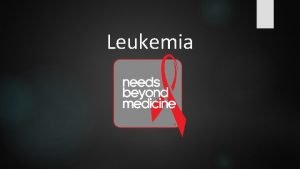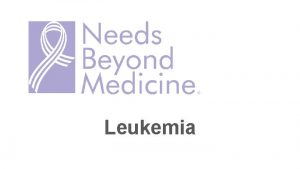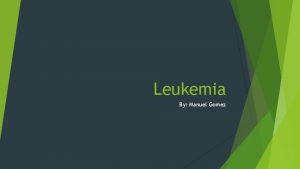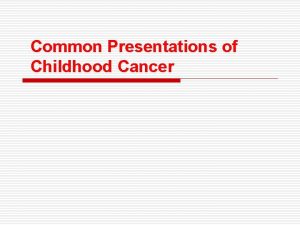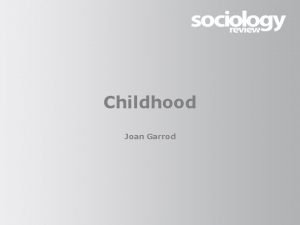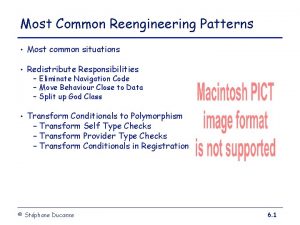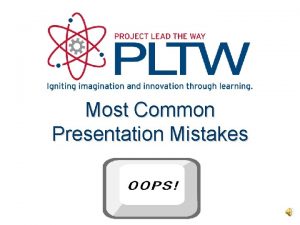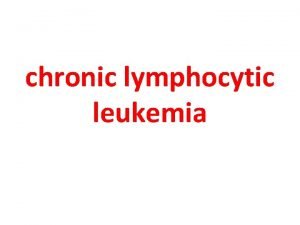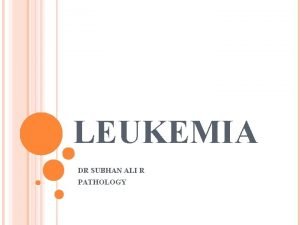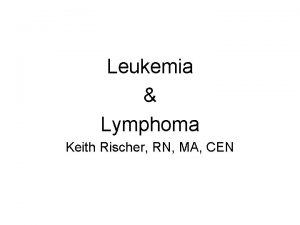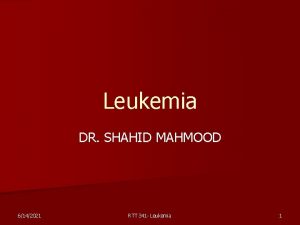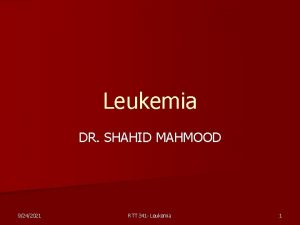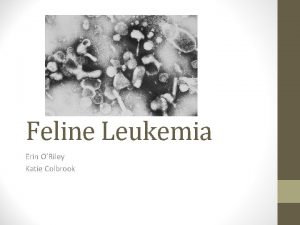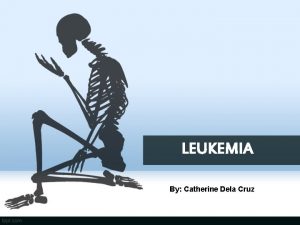LEUKEMIA Leukemia n n the most common childhood





































- Slides: 37

LEUKEMIA




Leukemia n n the most common childhood cancer counting for 33% of pediatric malignancy 병형 Acute lymphocytic 비율(%) 70~80 비율(한국, %) 60 Acute myelocytic 10~20 30 Acute monocytic 3~8 5 Chronic myelocytic 2~5 3 2 2 기타

급성림프구성 백혈병 (Acute Lymphocytic Leukemia)

n n About 75% of all cases (60% in Korea) Peak incidence : 4 yr

Pathology n Subclasses according to morphologic, n immunologic, n genetic feature of leukemic blast n n n Definite diagnosis by bone marrow aspiration Chromosomal abnormalities n 80~90% in childhood ALL

Pathology n FAB class L 1: small lymphoblast predominant with little cytoplasm n L 2: larger & pleomorphic with increased cytoplasm. Irregular nuclear shape, predominant nucleoli n L 3: fine stippled and homogenous nuclear chromatin, predominant nuclei and deep blue cytoplasm with predominant nucleoli n

L 1 bone marrow

L 2 bone marrow

L 3 bone marrow

Clinical Manifestation n The first symptoms n n Pallor(anemia), bleeding(thrombocytopenia), and fever(neutropenia, malignancy) n n usually nonspecific (anorexia, irritability, and lethargy) prompt Dx About 50% n petechiae or mucous membrane bleeding

Clinical Manifestation n n Lymphadenopathy, splenomegaly, bone pain, arthralgia, … Rarely, signs of increased ICP ; headache and vomiting n n leukemic meningeal involvement T-cell ALL older and more often male n 66% have an anterior mediastinal mass n

n Diagnosis most have anemia n n thrombocytopenia n n by examination of bone marrow chest radiograph n n by the presence of blast cells on a PBS confirmed n n 25%에서 platelet counts > 100, 000/mm 3 suggested n n 25% 에서 Hb < 6 g/d. L mediastinal mass CSF examination for leukemic cells

Differential Diagnosis n Aplastic anemia and myelofibrosis, infectious mononucleosis infiltrate marrow a. b. c. d. Neuroblastoma Rhabdomyosarcoma Ewing sarcoma Rarely retinoblastoma

Treatment n Induction of remission n n Vincristine, prednisone, L-asparaginase with hydration, allopurinol, and sodium bicarbonate CNS prophylaxis RT(1800 Rad/2 wks) + IT MTX (6 times) n Good prognosis group – IT MTX n 최근 triple IT therapy n n MTX + Ara-C + hydrocortisone : weekly 6 times, then 2 months interval for 1 yr

Treatment n Maintenance of remission n n MTX, 6 -mercaptopurine (vincristine, prednisone) Immunotherapy Hematopoietic stem cell transplantation Supportive therapy Treatment about infection n Transfusion n Uric acid nephropathy 예방 n Oral hygiene n

Relapse n n The bone marrow is the most common site of relapse Extramedullary sites ; CNS and testes 1) CNS relapse ; increased ICP vomiting, headache, papilledema, and lethargy v 2) Tx : intrathecal chemotherapy and cranial irradiation Testes ; painless swelling of one or both testicles v Tx : irradiation of the gonads

Prognosis 예후 불량 요소 n a. b. c. d. e. f. g. h. i. j. k. l. Peripheral WBC count > 100, 000 /m. L 2 세 미만 or 10세 이상 Severe hepatomegaly or splenomegaly Male sex Leukemia cell ploidy 50 chromosome 또는 그 이하 Chromosomal translocation 의 존재 Platelet count < 100, 000 / mm 3, high Hb level Superior mediastinal mass FAB L 2 or L 3 B cell, T cell or pre-B cell Presence of CNS leukemia PAS 시약에 대한 blast cell 활성도의 감소

급성 골수구성 백혈병 (Acute Myeloid Leukemia)

Incidence n n n 15~20% of all childhood leukemias Neonatal or congenital leukemia 의 대부분 Trisomy 21, Fanconi anemia, Diamond. Blackfan anemia, Kostmann syndrome and Bloom syndrome에서 높은 incidence 를 보임. 또한 다른 악성 종양으로 치료받은 경우에서도 증가

Clinical Manifestation n n Signs and symptoms attributable to bone marrow failure initially with only anemia, leukopenia, or thrombocytopenia Bone pain is less common than in ALL Liver and spleen enlargement is common; lymphadenopathy Unexplained gingival hypertrophy or parotid gland swelling

Diagnosis n n The presence of at least 30% leukemic blast cell in the bone marrow Morphology and cytochemical analysis n n histochemical stain positive for myeloperoxidase, Sudan black, or nonspecific esterase FAB system

Diagnosis n Hemorrhagic diathesis (DIC at presentation or later) n n Translocation between chromosomes 8 and 21 (M 2) n n M 3 closely associated with chloroma Trisomy 8 and complete or partial deletion of chromosome 5 or 7

Diagnosis n Myelodysplastic syndrome n Resemblance to AML, but lower percentage of blast cells and characteristic features, including megaloblastosis

Diagnosis n Juvenile chronic myelogenous leukemia (JCML) n n n Unlike adult type CML, but may have features similar to those of AML, and myelodysplastic syndrome No philadelphia chromosome Nonspecific symptome : fever, malaise, liver and spleen enlargement, adenopathy Chronic despuamative maculopapular skin eruption Hb F ↑ (50%), leukocytosis 5세 이후에는 rare, type I neurofibromatosis에 호발

Treatment n Chemotherapeutic regimens : n n Retinoic acid as initial treatment for acute proyelocytic leukemia n n n anthracycline (daunorubicin, idarubicin) and cytarabine Reduce the risk of the hemorrhage, but is not curative Autologous or allogenetic bone marrow transplantation Intrathecal chemotherapy n Necessary to prevent CNS relapse

Prognosis n n Poor With aggressive therapy, 40~50% fo patients who achieve remission will survive (30~40% overall cure rate)

만성 골수성 백혈병 (Chronic Myeloid Leukemia)

n n n A clonal malignancy of the hematopoietic stem cell characterized by a specific translocation, the t(9; 22)(q 34; q 11) Philadelphia chromosome More common in adults and accounts for only 3 % of childhood leukemia Progression to a myeloid or lymphoid blast crisis

Pathology n n n Characterized by myeloid hyperplasia with increased numbers of differentiating myeloid cells in blood and bone marrow Philadelphia chromosome ; more than 95% Bcr-abl rearrangement (southern blot analysis or polymerase chain reaction technique)

Clinical Manifestation n Symptoms of hypermetabolism n n Weight loss, anorexia, and night sweats Symptoms of leukostasis n Visual disturbance or priapism, occur rarely

Diagnosis n Elevated white blood cell counts n n Elevated serum levels n n exceed 100, 000 /mm 3 with all forms of myeloid cells seen in the blood smear abnormally high platelet counts of vitamin B 12 and uric acid and reduced or absent leukocyte alkaline phosphatase activity Bone marrow n n Hypercelluar, with normal myeloid cells in all stages of differentiation. Megakaryocytes may be numerous Philadelphia chromosome

Treatment n Chemotherapy with busulfan (Myleran), or hydroxyurea 1. Chronic phase 1) 2) 3) 4) 2. Lymphoid blast crisis v 3. Busulfan Interferon alpha Glivecc (signal transduction inhibitor) Allogenic BMT Standard ALL treatment Myeloid crisis v Refractory to standard AML treatment


선천성 백혈병 n n Diagnosis within the first month of life Most cases are myeloid leukemia marked leukocytosis, petechiae, ecchymoses, and extramedullary involvement, massive hepatosplenomegaly, cutaneous nodule, and CNS leukemia n n n Occurs primarily in neonates with trisomy 21 or chromosome 21 mosaicism Poor prognosis Leukemic cell chromosome rearrangement affecting the q 23 region of chromosome 11
 Leukemia survival rate
Leukemia survival rate Middle childhood
Middle childhood Suffix penia
Suffix penia Leukemia statics
Leukemia statics Leukocyte alkaline phosphatase increased
Leukocyte alkaline phosphatase increased Hairy cell leukemia
Hairy cell leukemia Acute promyelocytic leukemia
Acute promyelocytic leukemia Surgical suffixes examples
Surgical suffixes examples Zhang wang leukemia
Zhang wang leukemia Mark juckett md
Mark juckett md Treatment of cml
Treatment of cml Lll leukemia
Lll leukemia Leukemia
Leukemia Chronic myeloid leukemia
Chronic myeloid leukemia Lymphoma vs leukemia
Lymphoma vs leukemia Trombopoetik adalah
Trombopoetik adalah Leukemia
Leukemia Myeloperoxidase stain principle
Myeloperoxidase stain principle Acute mylogenous leukemia
Acute mylogenous leukemia Chronic myeloid leukemia
Chronic myeloid leukemia Differentiation syndrome
Differentiation syndrome Conclusion differentiation
Conclusion differentiation Funkcie krvi
Funkcie krvi Leukemia statics
Leukemia statics Nk leukemia
Nk leukemia Factor tree of 28
Factor tree of 28 Multiples of 9 and 21
Multiples of 9 and 21 Highest common factors and lowest common multiples
Highest common factors and lowest common multiples What is the greatest common factor of 12 and 42
What is the greatest common factor of 12 and 42 Lcm of 4 8 and 16
Lcm of 4 8 and 16 Common anode and common cathode
Common anode and common cathode Các châu lục và đại dương trên thế giới
Các châu lục và đại dương trên thế giới Từ ngữ thể hiện lòng nhân hậu
Từ ngữ thể hiện lòng nhân hậu Bổ thể
Bổ thể Tư thế ngồi viết
Tư thế ngồi viết V cc
V cc 101012 bằng
101012 bằng Thể thơ truyền thống
Thể thơ truyền thống



